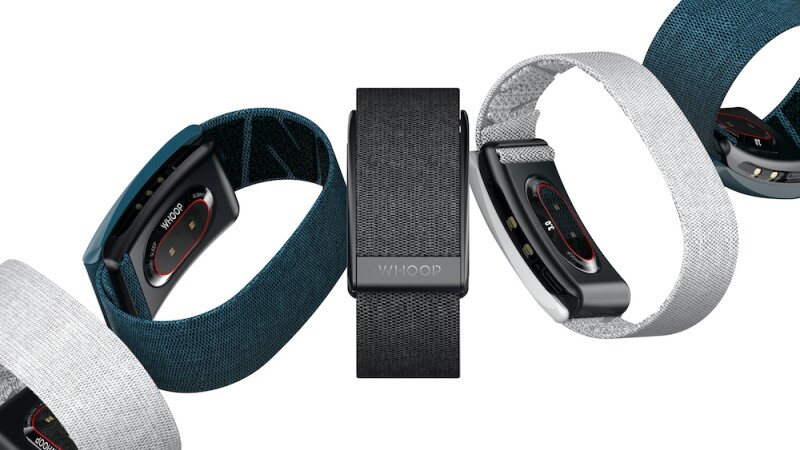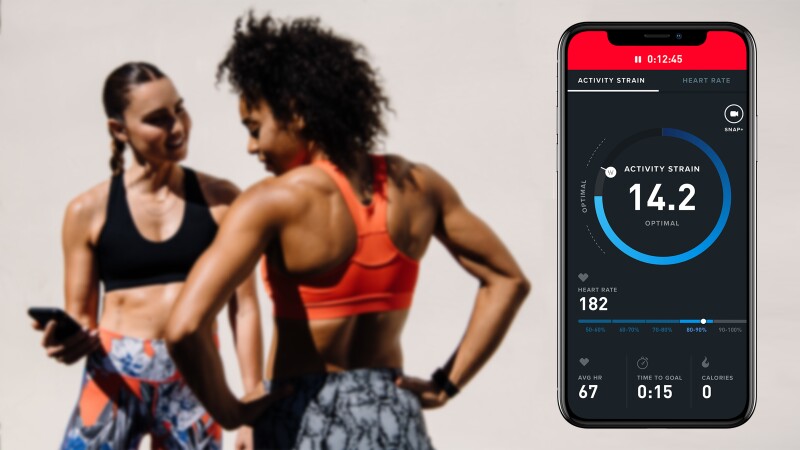Often seen on the wrists of some of today’s top athletes like UCI Mountain Bike World Champion Kate Courtney and 11-time PGA Player of the Year Tiger Woods, WHOOP is a heart-rate monitor and fitness tracker worn 24 hours a day that promises to help optimize athletic performance.
There are two parts: the strap itself, which comes in a variety of interchangeable materials (including a quick-drying polyester) and a sensor system that sits against your skin (think: Apple Watch but without the screen) that monitors a slew of different stats.

The sleep data is what got me hooked. Every single day I toggle the device’s accompanying iOS app before the sun comes up to see how I slept compared to prior nights. After tapping my way through a simple behavioral questionnaire (otherwise called “The WHOOP Journal”), including prompts like “Did you consume alcohol yesterday?” and “Did you share your bed last night?”—I’m greeted with recovery and sleep performance scores, triggered by my user data. These scores offer insight on how to level-up my performance over the course of the day. It’s a bit addicting.
But what’s the point of WHOOP outside of gamifying sleep? And is it worth its monthly subscription fee? Let’s dive in.
Which Health Indicators Does WHOOP Track?
The WHOOP Strap 3.0 (the newest version) employs a three-axis accelerometer, three-axis gyroscope, LEDs, and photoplethysmography—a practice that uses light to detect changes in blood volume—to track a variety of metrics, including:
- Heart rate variability (HRV), the variance in time between each heartbeat. Higher HRV is typically a sign of better fitness and overall recovery.
- Resting heart rate (RHR), the number of times your heart beats per minute when you’re at rest. A low RHR generally signifies a strong, healthy heart and rested body.
- Respiratory rate, or respirations per minute (RPM), the number of breaths you take per minute. A rise in RPM may help signal the onset of illness.
Whoop then uses this data to calculate your sleep, “strain,” and recovery. It’s worth digging into each of these a bit.

1. Sleep
WHOOP measures your sleep latency (how long it took you to fall asleep, sleep duration (how long you slept), sleep quality (how much time you spent in each sleep stage, sleep disturbances (short periods of wakefulness), and sleep efficiency (the percentage of the time you spent in bed and were actually asleep). WHOOP then uses this data to calculate your overall Sleep Performance, a score between zero and 100%.
But unlike many other sleep trackers, WHOOP doesn’t just feed you this data, it helps you use it. The app includes a Sleep Coach that recommends a sleep schedule based on your circadian rhythm (research shows that irregular sleep patterns can cause more daytime sleepiness and—at the extreme end of the spectrum—double your risk of heart disease) and an optimal sleep duration based on your preferred performance level the next day (“get by,” “perform,” or “peak”).
2. Strain
Plotted on a scale from zero to 21, strain is a measure of how hard your cardiovascular system worked. It’s calculated by measuring how much time you spend in each of your personal heart rate zones, with higher heart rates contributing to more strain.
WHOOP tracks two types of strain: activity strain and day strain.
Activity Strain
WHOOP automatically detects activity based on an increase or decrease in resting heart rate. If you’re doing something outside the box (think: baseball, caddying, coaching, or even taking an ice bath)—you can go into the app and choose from a laundry list of options to manually log your activity. When you complete your session the app will show you your activity strain score, as well as how long you exercised, how many calories you burned, and a variety of heart-rate data.

According to WHOOP, all-out workouts are 18 and above; strenuous workouts are typically 14-18; moderate workouts are typically 10-14; and everything below 10 represents degrees of light or minimal activity. However, your score is personalized, in that two people who do the exact same workout may get a different strain score based on each person’s fitness level. For instance, a five-mile run will be easier for a professional marathon runner than a layperson.
Daily Strain
The same rules apply to your daily strain score, except instead of just taking one activity into consideration, your daily strain score takes into account any cardiovascular stress you experience (from things like exercise, travel, work, commuting) over the course of a day.
The idea behind the daily strain score is this: By understanding how much stress your body is under—and what most contributes to it—you can tailor your day-to-day activities to reduce your risk of illness and injuries, which can occur when you train too much and don’t rest enough.

3. Recovery
Recovery is “a measure of your body’s readiness to respond to a training stimulus,” or “how ready your body is to take on strain,” says Emily Capodilupo, WHOOP’s director of analytics. It’s calculated based on your HRV, RHR, sleep performance, and RPM and is reported on a scale from zero to 100%.
Wake up “in the red” with a low recovery score? That’s a solid indication that your body needs time to rest and rejuvenate. "In the green”? That means you’re ready to take on a solid workout. The yellow zone means you should proceed with caution; your body will respond to training but you’re not at your peak potential.
How Well Does WHOOP Work?
Ask any professional athlete and they’ll likely tell you that when it comes to getting into top shape, getting adequate rest is just as—if not more—important than training. That’s because workouts challenge your heart and muscles, and sleep is what allows your body to adapt to those workouts and come back stronger.
And according to Whoop, “By balancing your daily recovery, strain and sleep, you will train optimally and unlock the secrets to your body’s true potential.” Whether you need to wear a WHOOP strap to reap those rewards remains to be seen—WHOOP has yet to be validated in an independent peer-reviewed study—but preliminary company-sponsored research has started to bear this out. Here are some highlights:
- A small 2020 study in the Journal of Clinical Sleep Medicine found that WHOOP accurately measures heart rate, respiratory rate, sleep duration, slow-wave sleep (SWS), and rapid eye movement (REM) sleep compared to polysomnography, the gold standard of clinical sleep tracking. The 32 healthy study volunteers also reported experiencing fewer sleep disturbances while wearing the device.
- In 2016, 10 NCAA Division I collegiate female cross‐country athletes wore WHOOP straps during their 12-week season. When researchers reviewed the runners' data, they noticed a correlation between higher RHR, lower HRV, and a greater percentage of time spent in SWS at the end of the seasons when the athletes were most run down. In other words, the study seems to support two key parts of WHOOP’s algorithm—that high RHR and low HRV are good indicators of fatigue—as well as the importance of prioritizing rest when your body needs to recover.
- In 2015, WHOOP outfitted 119 NCAA Division I athletes across eight teams with trackers. After crunching the data, WHOOP researchers found that the average athlete's resting HR decreased by 4.4 beats per minute while their average heart rate variability increased by 8.3 milliseconds. “Both of these changes constitute evidence of significant increases in cardiovascular fitness that are expected to correlate with increased athletic performance as well,” writes Emily Breslow, WHOOP’s lead quantitative physiologist and analytics manager.
- Early research outlined in the same white paper also shows that athletes reduced their rate of reported injuries by 60% over their first 129 days using WHOOP, a number that’s consistent with a 2011 Stanford University sleep study.
Research aside, how much you get out of WHOOP may depend on what you put into it. “Think of it as a tree-falling-in-the-woods situation,” says Dr. W. Chris Winter, author of “The Sleep Solution: Why Your Sleep Is Broken and How To Fix It” and renowned sleep specialist. “If you wear the WHOOP but don’t want to engage or alter your behaviors based upon it, then it’s a mistake to wear it in the first place. But if you’re generally interested and want to improve things, then it’s great. WHOOP could help to promote the right amount of sleep as well as a consistent schedule, especially if you’re seeing negative readouts time and time again—no one wants that.”
How Does WHOOP Compare to Other Popular Trackers?
There is a wide variety of smartwatches and fitness trackers available on the market today, so what are the reasons to choose WHOOP?
If you’re focused on counting steps or logging your meals or if you’re looking for an all-in-one tracker that doubles as a watch, then WHOOP may not be the device for you.
If you’re a competitive athlete or if you're incredibly into fitness, the quantified self, and/or biohacking, WHOOP may be able to help you optimize your performance.

WHOOP’s sleep tracking is what drew me to the device and keeps me as an active user to this day—it’s so much better than anything else I’ve tried.
However, as a runner, there are certain actions I value being able to do on a wrist-worn wearable while running that are not available on WHOOP, due to its lack of a screen. These features include taking a quick peek at my pace or following a Strava route on my Garmin. So in order to do these things, I often wear two devices on my wrist at once. Sure, it looks a little silly, but having access to WHOOP’s sleep tracking overrides the slight dork-factor for me—no questions asked.
WHOOP’s design also makes doubling up on devices feasible. The slim band isn't intrusive, and if you go with a plain black version, it's fairly inconspicuous.
How Much Does Whoop Cost?
Unlike other devices put out by popular wearable companies including Fitbit, Apple, Garmin, and Polar, you don’t pay a flat fee for the WHOOP strap. Instead, you get the WHOOP Strap 3.0 free when you join their $30-a-month membership program. WHOOP requires a six-month commitment to start (so $180 total) or you can pre-pay for a year or a year and a half to save up to $12 a month. Additional bands and accessories cost extra.
At the end of the day, in order to decide whether WHOOP is worth it, you have to ask yourself: What are you willing to invest in your health, and can you commit? Sure, $180 makes for an expensive test drive, but it's still cheaper than the cost of many other wearables upfront. Plus, in my eyes, the monthly membership holds you accountable and makes you more likely to use the device—and I’m certainly no professional athlete.






